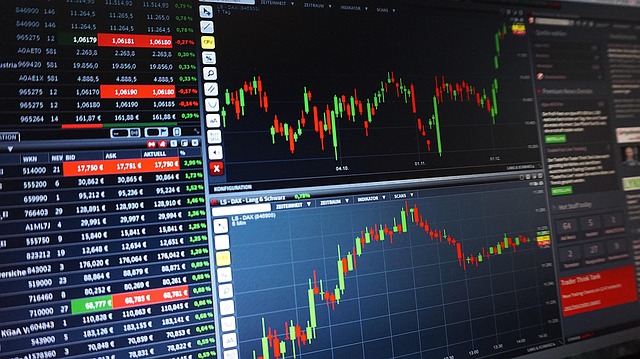The Quantum Leap: AI-Driven Quantitative Trading Strategies
In the ever-evolving landscape of financial markets, a new frontier is emerging at the intersection of artificial intelligence and quantitative trading. This cutting-edge approach, known as AI-driven quantitative trading, is revolutionizing how investors analyze data, make decisions, and execute trades. By harnessing the power of machine learning algorithms and big data analytics, traders are gaining unprecedented insights into market patterns and trends, potentially unlocking new levels of profitability and efficiency.

The Evolution of Quantitative Trading
Quantitative trading has come a long way since its inception in the 1980s. Initially, quant traders relied on relatively simple statistical models and historical data analysis to identify trading opportunities. As computing power increased and data became more readily available, these strategies evolved to incorporate more complex mathematical models and algorithms.
The advent of AI and machine learning has ushered in a new era of quantitative trading. These technologies enable traders to process vast amounts of data in real-time, identify complex patterns that may be invisible to human analysts, and adapt strategies dynamically based on changing market conditions. This shift from static, rule-based systems to dynamic, learning algorithms represents a quantum leap in the field of quantitative finance.
The Role of AI in Modern Quant Strategies
Artificial intelligence is transforming quantitative trading in several key ways. First, machine learning algorithms can analyze enormous datasets, including both structured and unstructured data, to identify subtle correlations and predictive patterns. This capability goes far beyond traditional statistical analysis, allowing traders to gain insights from diverse sources such as social media sentiment, satellite imagery, and even weather patterns.
Furthermore, AI systems can continuously learn and adapt to changing market conditions. Unlike traditional quant models that may become outdated as markets evolve, AI-driven strategies can adjust their parameters in real-time, maintaining their effectiveness even in volatile or unpredictable environments. This adaptive capability is particularly valuable in today’s rapidly changing financial landscape.
Key Components of AI-Driven Quant Strategies
At the heart of AI-driven quantitative trading are several core technologies and methodologies. Deep learning neural networks, for instance, can be trained on historical market data to identify complex, non-linear relationships between various factors and future price movements. These models can then be used to make predictions and inform trading decisions.
Natural language processing (NLP) is another crucial component, allowing AI systems to analyze news articles, social media posts, and other text-based sources to gauge market sentiment and identify potential trading triggers. By incorporating this qualitative data alongside traditional quantitative metrics, AI-driven strategies can gain a more comprehensive view of market dynamics.
Reinforcement learning, a branch of machine learning inspired by behavioral psychology, is also finding applications in quantitative trading. These algorithms can learn optimal trading strategies through trial and error, continuously refining their approach based on the outcomes of their actions.
Challenges and Considerations
While AI-driven quantitative trading offers exciting possibilities, it also presents unique challenges. One major concern is the potential for overfitting, where models become too closely tailored to historical data and fail to generalize well to new market conditions. To mitigate this risk, traders must employ rigorous cross-validation techniques and maintain a healthy skepticism towards model predictions.
Another challenge lies in the interpretability of AI models. Many machine learning algorithms, particularly deep neural networks, operate as “black boxes,” making it difficult to understand the reasoning behind their decisions. This lack of transparency can be problematic from both a regulatory and risk management perspective.
Data quality and availability also remain significant hurdles. AI models are only as good as the data they’re trained on, and ensuring access to high-quality, comprehensive financial data can be both expensive and technically challenging.
The Future of AI in Quantitative Trading
As AI technologies continue to advance, we can expect to see even more sophisticated and powerful quantitative trading strategies emerge. Quantum computing, for instance, holds the promise of solving complex optimization problems at unprecedented speeds, potentially revolutionizing areas like portfolio optimization and risk management.
Edge computing and 5G networks could enable near-instantaneous data processing and decision-making, further reducing latency in high-frequency trading strategies. Meanwhile, advances in explainable AI may help address the interpretability challenges associated with complex machine learning models.
Essential Insights for AI-Driven Quant Trading
-
Diversify your AI models: Rely on multiple algorithms and data sources to reduce the risk of model failure.
-
Prioritize data quality: Invest in high-quality, diverse datasets to train your AI models effectively.
-
Implement robust risk management: Use AI for both alpha generation and risk mitigation.
-
Stay updated on regulatory developments: AI in finance is likely to face increasing scrutiny and regulation.
-
Cultivate interdisciplinary teams: Combine expertise in finance, data science, and AI to build effective strategies.
-
Embrace continuous learning: Markets evolve rapidly, so ensure your AI systems can adapt and learn in real-time.
-
Consider ethical implications: Be mindful of the potential societal impacts of AI-driven trading strategies.
As we stand on the cusp of this new era in quantitative finance, it’s clear that AI-driven strategies will play an increasingly important role in shaping the future of investment and trading. While challenges remain, the potential for AI to unlock new levels of market insight and trading efficiency is undeniable. For investors and financial professionals alike, understanding and harnessing these technologies will be crucial to staying competitive in the rapidly evolving world of quantitative finance.





